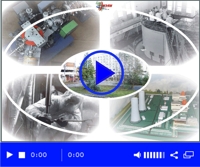About us
The Joint Institute for Power and Nuclear Research – Sosny of the National Academy of Sciences of Belarus is the legal successor of the Nuclear Power Engineering Institute of the BSSR Academy of Sciences, founded on June 22, 1965.
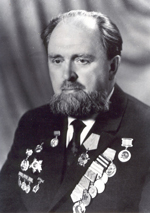
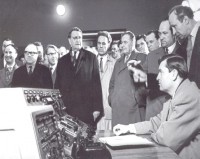 The first Institute Director was Academician A. K. Krasin
The first Institute Director was Academician A. K. Krasin
Andrew Kapitonovich Krasin (21.05.1911 – 28.03.1981) is a great nuclear power energy scientist. He was an academician of National Academy of Sciences of Belarus (1960), doctor of physical and mathematical sciences (1955), professor (1957). He was awarded by the name of Honored Science and Techniques Worker of BSSR (1968).He participated in Great Patriotic War. He graduated Tomsk University in 1934. In period 1934-1940 he worked in Siberian physical and technical Institution and in Tomsk University as senior lecturer. In 1945 A.K. Krasin worked in I.V. Kurchatov laboratory.
From 1946 he worked in Obninsk Physical-Energetic Institution – as a scientific vise-director, then in 1956-1959 as director and in 1959-1961 as a researcher. In 1961 he becomes a leader of atomic energy department in the Institute of Energy of AS BSSR. In 1965-1977 he was a director of Nuclear Energy Institution of AS BSSR. Simultaneously, he was Academician-Secretary of Physical-Engineering Science Department of AS BSSR. From 1977 he was a head of hydrogen energetics laboratory of Heat and Mass Transfer Institution of AS BSSR.
Scientific research of Krasin was devoted to physics of interactions between radiation and substances, development and building nuclear power stations. He participated in creation of the first in the world Beloyarsk nuclear power plant (Obninsk). He participate also in development of reactors and heat-transfer agents
He was ordered by Lenin premium in 1957 for the development of the first in the world nuclear power plant. He is an author of more than 350 scientific works and special developments, 3 books and several inventions.
A. K. Krasin was ordered by Lenin order (1958), October revolution order (1971), order of Patriotic War II-degree (1945) and several medals.
Main publications: Energetic nuclear reactors, M. 1957; Atomic electrical power stations, M. 1959; Reactors of nuclear power plants, Minsk, 1971.
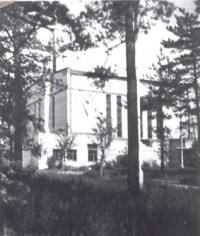 Institute had commissioned an on-site research nuclear reactor IRT-1000 the capacity of which was subsequently increased to 4,000kW; a laboratory for physical capacity reactors and a test building with thermophysical experimental installations. Works on creating a radiochemical laboratory with hot cells for operations with highly- active materials and substances were close to completion.
Institute had commissioned an on-site research nuclear reactor IRT-1000 the capacity of which was subsequently increased to 4,000kW; a laboratory for physical capacity reactors and a test building with thermophysical experimental installations. Works on creating a radiochemical laboratory with hot cells for operations with highly- active materials and substances were close to completion. 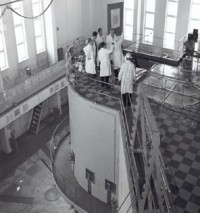 In 1973, a Special Design Bureau with pilot production facilities was founded and the first line of experimental production facilities was constructed, to include special stands, installations and new technological processes for manufacturing and testing nuclear power equipment. Since the foundation of the Nuclear Power Engineering Institute and until the Chernobyl accident, the Institute primarily specialized in such basic and applied research areas as material- radiation interaction, development of gas-cooled slow- and fast-neutron nuclear reactors and application of ionizing radiation sources in the national economy. Assisted by over 150 organizations and enterprises of the USSR in 1985 the Institute created and started-up the world’s first mobile nuclear power plant Pamir-630D with a thermal power of 10 MW (electric output of640 kW) with dissociated coolant and N2O4-based nitrine working fluid.
In 1973, a Special Design Bureau with pilot production facilities was founded and the first line of experimental production facilities was constructed, to include special stands, installations and new technological processes for manufacturing and testing nuclear power equipment. Since the foundation of the Nuclear Power Engineering Institute and until the Chernobyl accident, the Institute primarily specialized in such basic and applied research areas as material- radiation interaction, development of gas-cooled slow- and fast-neutron nuclear reactors and application of ionizing radiation sources in the national economy. Assisted by over 150 organizations and enterprises of the USSR in 1985 the Institute created and started-up the world’s first mobile nuclear power plant Pamir-630D with a thermal power of 10 MW (electric output of640 kW) with dissociated coolant and N2O4-based nitrine working fluid.  The plant was to be used as an independent electric power source for mobile and stationary facilities located in poorly accessible regions of the USSR. Simultaneously, research and design work was underway to design an NPP with a fast breeder reactor with dissociated coolant. There was developed an engineering design of a pilot nuclear power station with a fast breeder reactor BRIG-300 (electric output of 300 MW). In those years the Institute became one of the USSR’s major research centers for nuclear power.
The plant was to be used as an independent electric power source for mobile and stationary facilities located in poorly accessible regions of the USSR. Simultaneously, research and design work was underway to design an NPP with a fast breeder reactor with dissociated coolant. There was developed an engineering design of a pilot nuclear power station with a fast breeder reactor BRIG-300 (electric output of 300 MW). In those years the Institute became one of the USSR’s major research centers for nuclear power. 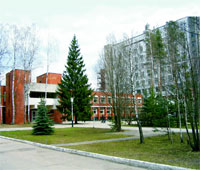 Immediately after the accident at the Chernobyl Nuclear Power Station the Institute became actively involved in solving such critical problems as identifying levels of radiological contamination of the country’s territory with radio-nuclides and exposure levels of the population in affected areas, testing domestically-produced foodstuffs for radiological contamination which played an important role in determining the strategy and tactics of radiological safety activities. At present the Institute’s staff consists of 380 employees including 15 researchers with Doctor of Sciences degreе and 45 with Ph. D.
Immediately after the accident at the Chernobyl Nuclear Power Station the Institute became actively involved in solving such critical problems as identifying levels of radiological contamination of the country’s territory with radio-nuclides and exposure levels of the population in affected areas, testing domestically-produced foodstuffs for radiological contamination which played an important role in determining the strategy and tactics of radiological safety activities. At present the Institute’s staff consists of 380 employees including 15 researchers with Doctor of Sciences degreе and 45 with Ph. D.
Products and services:
radiation sterilization of medical goods, foodstuff and other products; radiation resistance analysis of materials and goods; development of radiation technologies for new materials and materials having new properties production; plasma-electrolytic treatment of metal products; flowmeters and heat-meters verification; energy saving equipment development; gamma-spectrometric support for radiochemical refinement and determination of radionuclide preparations’ characteristics; identification and characterization of isotopic compositions and activities of ionizing radiation sources; radon and its decay products monitoring; sealed radiation sources and decommissioned gamma-installations utilization
The Institute participated in the following establishments:
- Joint Belarusian-Italian enterprise “Belocryo” LLC (1993) for the production of import-substituting products for Belarus – cryogenic tanks for long-term storage and transportation of liquefied gases, gasifiers for cryogenic liquids (21 people, the volume of work performed is 1606.9 million rubles, including 80% of scientific and technical products).
- Scientific and Production Republican Unitary Enterprise “BelIKO” of the National Academy of Sciences of Belarus (1997) for the creation of automated systems for radiant provision of technological conditions (20 people, the volume of work performed is 1803.256 million rubles, including 100% of scientific and technical products)
- Joint Belarusian-Russian Closed Joint-Stock Company Closed Joint-Stock Company «Isotope Technologies» (1998) for the production of ionizing radiation sources for medical and industrial purposes (51 people, volume of work performed 6247.1 million rubles, including 25% of scientific and technical products).
The joint Belarusian-Russian Closed Joint-Stock Company “Isotope Technologies” is a subordinate organization of the scientific institution “Joint Institute for Power and Nuclear Research – Sosny”.
CJSC “Isotope Technologies” is the main enterprise in the Republic of Belarus, providing a full range of services in the field of handling radioactive materials for medical, industrial and scientific purposes. The enterprise has established a production facility for radioactive materials (RM) and manufactures sealed sources of ionizing radiation (SIR), for the production of which a chain of “hot cells” is used.
By order of the IAEA, the AGAT-METROLOGY radiation installation has been developed and implemented, which is intended for calibrating dosimetric instruments and irradiating various objects with collimated beams of high-power gamma radiation. CJSC Isotope Technologies is the main exporter-importer of radioactive materials, as well as radiation technologies and services in the Republic of Belarus. Enterprises of the republic are provided with services for import and customs clearance of radioactive cargo.
Today, CJSC Isotope Technologies is a unique enterprise for Belarus, occupying a leading position in the market for the production and supply of radioisotope products in the republic, and in the world for the production of medical sources for contact radiation therapy devices
based on the radionuclide 60Со.
The following are among the new and very promising scientific areas:
- development of methods for modeling neutron-physical and thermal-hydraulic processes and their application in substantiating the safety of the Belarusian NPP;
- calculation, theoretical and experimental substantiation of thermal-hydraulic and neutron-physical characteristics of power and research nuclear reactors;
- development of methods of probabilistic safety analysis of nuclear facilities;
- fundamental and applied research in the physics and kinetics of subcritical systems based on the synthesis of fission and fission reactions (Accelerator Driven Systems) and technologies for burning long-lived waste (Accelerator Driven Transmution Technologies);
- development of technologies based on particle and radiation sources for the production of micro-, nano- and optoelectronics products, precision surface treatment of materials, radiation testing and modification of polymer products, production of medicines and drugs, sterilization of medical products, etc. (NG-12-1, UELV-10-10, UGU-420, “Giatsint” stand), development of high technologies using ionizing radiation;
- development of supercomputer and Grid technologies and their application in nuclear physics and power engineering;
- development of precision non-destructive testing methods and expert testing of radioactive materials;
- development of a methodology for monitoring energy security and measures to reduce the likelihood of threats to energy security and ensure the operation of the republic’s fuel and energy complex in emergency situations;
- research and optimization of the efficient use of renewable energy sources (biomass, solar and wind energy);
- development of methods for assessing environmental and economic consequences and decision-making in emergency situations during radiation and nuclear accidents;
- development of technology for the production of a new generation of radiopharmaceuticals in the treatment of oncological diseases;
- development of technologies and measures to eliminate temporary radioactive waste disposal sites in the former locations of USSR troops and to prevent the negative consequences of the impact of radioactive waste storage facilities outside Belarus.
The Institute carries out a great deal of work on the implementation by the Republic of Belarus of the Treaty on the Non-Proliferation of Nuclear Weapons, the Convention on the Physical Protection of Nuclear Materials and the IAEA Safeguards Agreement on the Non-Diversion of Nuclear Materials from Peaceful to Military Use.

